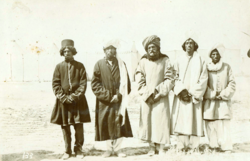Balúčové
| Balúčové بلوچ | |
|---|---|
 Íránští Balúčové v době kádžarovců, 1884 | |
| 6 900 000 (2013) | |
| 2 000 000[1][2] | |
| 468 000 (2014)[3] | |
| 312 000 (1993)[4] | |
| 30 000 [5] | |
| 16 000 [6] | |
| Jazyk(y) | |
| balúčština urdština, paštština (v Afghánistánu a Balúčistánu), bráhujština, arabština | |
| Náboženství | |
| převážně sunnitský islám[7] | |
| Příbuzné národy | |
| Paštunové | |
Balúčové (balúčsky بلوچ) jsou národ, který žije hlavně v oblasti Balúčistán, ležící na nejjižnějším okraji íránské vysočiny v Pákistánu, Íránu a Afghánistánu. Dále žijí na Arabském poloostrově.
Mluví hlavně balúčštinou, která patří mezi severozápadní íránské jazyky. Náleží k íránským národům. Přibližně 50 % z celkového počtu Balúčů žije v provincii Balúčistán na západě Pákistánu,[8] 40 % žije v Sindhu a významné množství i v Paňdžábu v Pákistánu. Tvoří asi 3,6 % pákistánské populace, okolo 2 % íránské (1,5 milionu) a zhruba 2 % afghánské populace.[9]
Spolu s Paštuny obývají pouště a horské regiony a praktikují islám, převážně sunnitský. Ke komunikaci s ostatními etnickými skupinami v regionu jako Paštunové a Sindhové používají urdštinu, která je taková lingua franca.
Reference
- ↑ Archivovaná kopie. www.atimes.com [online]. [cit. 2017-01-23]. Dostupné v archivu pořízeném dne 2014-10-20.
- ↑ GRASSI, Daniele. Iran's Baloch insurgency and the IS. www.atimes.com. 20 October 2014. Dostupné v archivu pořízeném dne 2014-10-20. (anglicky)
- ↑ United Arab Emirates: Languages [online]. [cit. 2016-10-24]. Dostupné online. (anglicky)
- ↑ Oman: Languages [online]. [cit. 2016-10-24]. Dostupné online. (anglicky)
- ↑ KOKAISLOVÁ, Pavla, KOKAISL Petr. Ethnic Identity of The Baloch People. Central Asia and The Caucasus. Journal of Social and Political Studies. Volume 13, Issue 3, 2012, p. 45-55., ISSN 1404-6091
- ↑ Baloch, Southern in Saudi Arabia, Joshua Project.
- ↑ Demography of Religion in the Gulf [online]. 2013. Dostupné online. (anglicky)
- ↑ Blood, Peter, ed. "Baloch". Pakistan: A Country Study. Washington: GPO for the Library of Congress, 1995.
- ↑ CENTRAL INTELLIGENCE AGENCY. The World Factbook: Ethnic Groups [online]. 2013 [cit. 2014-11-03]. Dostupné v archivu pořízeném dne 2019-01-06. (anglicky)
Související články
- Únos českých turistek v Balúčistánu
- Balúčistán (Pákistán)
- Sístán a Balúčistán
Externí odkazy
 Obrázky, zvuky či videa k tématu Balúčové na Wikimedia Commons
Obrázky, zvuky či videa k tématu Balúčové na Wikimedia Commons - [1].
Média použitá na této stránce
Flag of Iran. The tricolor flag was introduced in 1906, but after the Islamic Revolution of 1979 the Arabic words 'Allahu akbar' ('God is great'), written in the Kufic script of the Qur'an and repeated 22 times, were added to the red and green strips where they border the white central strip and in the middle is the emblem of Iran (which is a stylized Persian alphabet of the Arabic word Allah ("God")).
The official ISIRI standard (translation at FotW) gives two slightly different methods of construction for the flag: a compass-and-straightedge construction used for File:Flag of Iran (official).svg, and a "simplified" construction sheet with rational numbers used for this file.
Iranian Baloch khans in Qajar era, c. 1902






